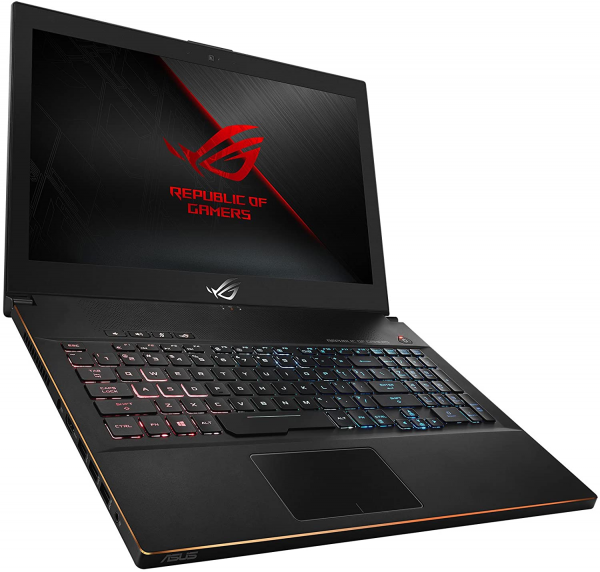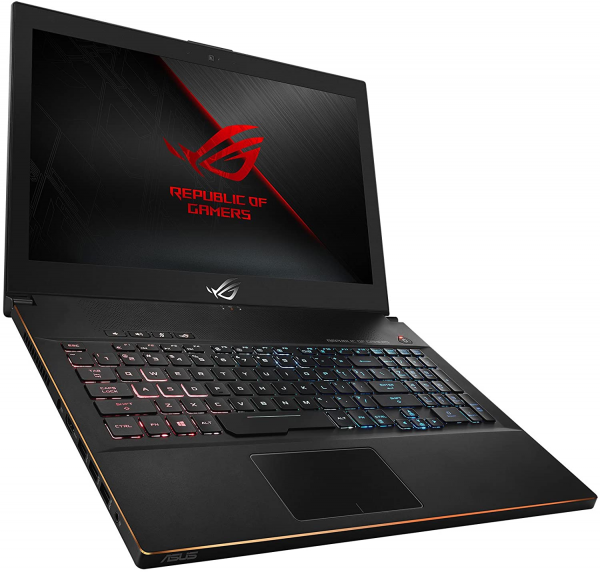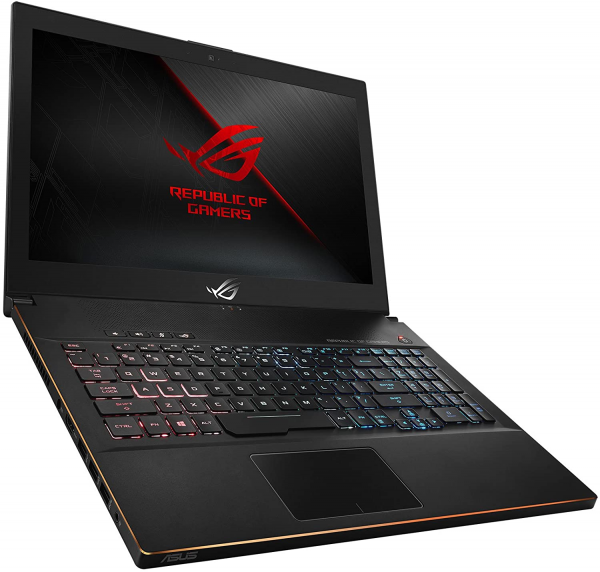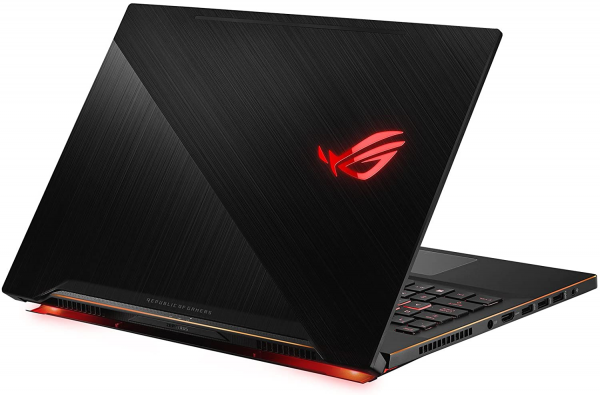Asus ROG
Asus ROG Zephyrus M gaming laptop: slim and very powerful
Aprox. 1999€
See specificationsAsus returns with a new Zephyrus and focuses on one goal: to make the most powerful gaming laptop possible in the thinnest chassis possible. Bet successful on this point for the Taiwanese company which delivers a good machine, at the price certainly of many concessions, including a screen which completely misses its subject.
Our review
Presentation
Of all the gaming laptops sold by Asus, the Zephyrus M is undoubtedly one of the most ambitious. Expected in May Certainly, it is not the most powerful PC of the brand, but it seeks to stand out on another point: offer an extremely solid configuration in a chassis of only 2 cm. We are testing here the GM501GS model equipped with an Nvidia GeForce 1070 which will be released in Spain in the coming weeks; a version equipped with the GeForce 1060 will also be offered under the reference GM501GM at a price of € 2,000.
The computer impresses on many points. Unfortunately, Asus engineers are not magicians and had to make some concessions to achieve this result.

Construction
Visually speaking, the Asus Zephyrus M is a great success. All in aluminum, the black chassis has been designed with angles; the result is a relatively sober aspect for a gaming PC. The "wow" effect is very present once the PC in hand, as it is so thin for its category. In his attention to detail, Asus has brought some welcome touches, such as a copper border on the edges, a cover of brushed aluminum in both directions and a very interesting element: the retractable foot.
Indeed, when closed, the Zephyrus M has everything of the classic portable PC. But at the opening, a retractable foot deploys mechanically under the chassis. The advantage is twofold: the keyboard is raised for more comfort and the ventilation of the computer is thereby facilitated. A nice technical design that we would like to see more often.
Once opened, the PC lets appear a keyboard and a touchpad of very beautiful invoice. The chiclet keyboard, without obviously bringing the comfort of a mechanical keyboard, is still very pleasant with its short stroke and its resistance. In addition, PCs for gamers have accustomed us to very mediocre trackpads and the Zephyrus manages to get out of the game by offering a touchpad that is pleasant to use and responsive. The user will still have plugged in a mouse to play, but the quality of this touchpad is something rare enough to be reported.
On the connection side, the Zephyrus M disappoints a little, while its finesse would not have been an obstacle in this area. It therefore has a USB 3.1 Type-C port, four USB 3.1 ports, an HDMI port and a jack port. Admittedly, the presence of four USB 3.1 ports is a plus, but we regret the absence of a DisplayPort and an SD card reader. Pity.
By housing such power in such finesse, it is difficult to work miracles in terms of heating and noise. After our usual test protocol (Metro benchmark: Last Light for one hour), the PC reveals mixed results. The heating is relatively high but remains controlled, never exceeding 56 ° C at the outlet of the grid. It is rather well distributed and especially well expelled by the fans. Fans which are not discreet, since at full speed, they give off 50 dB (A) in an unpleasant hissing (result obtained via our new test procedure which consists in measuring the sound at 50 cm from the PC in play). A huge flaw that will be difficult to bear for those who will be in the same room as the user.
Regarding consumption, the Zephyrus M is not very economical. It consumes 15 W in standby, rises to 62 W on the desktop and, in game, reaches 200 W. This is not the most demanding gamer PC we have tested, but it enters the top 3.
In short, the Zephyrus is still a technical feat on the part of Asus, which shows that it is possible to combine power and finesse with a few concessions (logical in terms of its configuration) on the control of temperature and noise.

Screen
The Zephyrus M has a 15.6-inch (39.6 cm) IPS IPS screen with a resolution of 1,920 x 1,080 px. The screen / front ratio, at 70.96%, is quite low because of the thick edges. Asus is putting a lot on this screen by touting in particular its refresh rate at 144 Hz, very useful for the game. Nevertheless, the manufacturer would have done better to dwell on other points too, in particular the calibration.
Contrast 1375: 1 Temperature 8230 K Colors Delta E = 4
Passed in our lab, the screen of the Zephyrus M delivers disappointing results. The contrast (which ensures a good vision of the shades of gray) is acceptable with its ratio of 1375: 1, just like the brightness (308 cd / m²). Delta E, witnessing the respect of colors, displays a correct average of 4, but on closer inspection, the greens, blues and reds are far from being faithful to the native colors. However, what strikes the most in the screen of this Zephyrus is the very high temperature of 8,230 K, sign of a strong drift of the screen towards blue. This is all the more disturbing given that it can be seen with the naked eye.
The refresh rate is 7 ms. An excellent score, of course, but far from the 3 ms promised by Asus on its official website. Note also the support of G-Sync technology, which always works wonders in game.
In summary, the Zephyrus M therefore disappoints enormously on this point: the screen is simply passable, when it should have been excellent, especially at this price.

Performances
The Zephyrus M is equipped with an Intel Core i7-8750H processor supported by 32 GB of RAM. With this configuration, it is logical that the PC is one of the most powerful that we have tested in our columns.
After our usual battery of tests (file compression, photo editing, audio and video conversion), the Zephyrus reaches the index of 158. This places it among the best PCs on the market in this area, if not the best in terms of portable, protruding a short head from the Aero 15X V8 with the same processor.
It also exceeds the ROG Strix GL702ZC, equipped with an AMD Ryzen 7 1700, but logically remains behind the MSI Vortex 25, a stationary computer which is equipped with a Core i7-8700.
The Zephyrus M will therefore offer a wide range of possibilities to its user, who will thus be able to run any software requiring great computing power - except of course graphic tasks requiring colorimetric precision (photo editing, calibration, etc.).
Games
Again, difficult to disappoint with an Nvidia GeForce GTX 1070 on board, with 8 GB GG video memory. In this area, the PC does not disappoint in any way, running all the big games of the moment without coughing.
During our usual tests (extreme settings, vertical synchronization disabled), the Zephyrus showed its muscles, spinning The Witcher 3 at 106 fps, Star Wars Battlefront II at 132 fps, Assassin's Creed Origins at 62 fps or Total War: Warhammer 2 at 82 fps . Thus, the user will have no worries about the game.
In terms of pure power, the Zephyrus gets the index of 130 in our test protocol, which places it in the average of current gaming PCs.
Mobility / Autonomy
Even if the Zephyrus M relies above all on its finesse, it remains in the great tradition of laptops for gamers; it is therefore more portable than portable, with its 2.5 kg - a relatively light weight for this range. However, its finesse and format make it easy to transport, the PC fits easily in a backpack.
Side autonomy, Asus promises a battery capable of holding almost 6 hours. In practice, the promise is far from being kept: with our usual protocol (Netflix in Chrome, brightness at 200 cd / m² and backlight off), it only lasted 2 hours and 49 min before going out. At low score, even for a computer dedicated to gaming.
Audio
Gaming laptops usually offer mediocre speakers compensated by a proper headphone jack, and the Zephyrus M is no exception to this rule.
The speakers, placed at the front of the PC, under the chassis, tend to vibrate and their sound depends a lot on the surface on which it is placed. Unfortunately, they are placed right where the user places their wrist in play, which is very unpleasant. In terms of sound quality, the Zephyrus M's speakers descend more in the bass (up to 200 Hz) than those of its competitors, failing to go very high in the treble. It should still note a high distortion in the midrange and low midrange, but the voices are well transcribed and perfectly intelligible. Another good point, the stereo is a nice width. Finally, the Zephyrus M comes with Sonic Studio 3 software from Asus which allows you to customize the sound according to the activity (games, cinema); however, the treatments applied are of no interest and it is better to deactivate the software on the first start.
The headphone jack is good, even if we would have liked its power to be higher.
Conclusion
Asus could have created a flagship gaming laptop with its Zephyrus M. But the devil is hiding in the details and the PC narrowly misses its essential status. If we can still spend on the heating and noise with regard to the on-board configuration (Intel Core i7-8750H processor, Nvidia GeForce GTX 1070 graphics card), erratic screen calibration, low autonomy and connectivity which would have deserved to be more supplied can constitute obstacles to the purchase. Defects all the more annoying that the PC shows itself for the rest very well finished and has excellent performance.
Specifications

